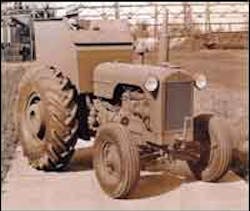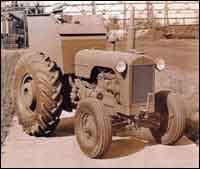Case Does Its Part in WW II
During World War II, Case produced and delivered more than 1.3 million howitzer shells; about 200 sets of bomber aircraft wings; nearly 20,000 specialized war tractors and engines; more than 1,400 Bofors anti-aircraft-gun carriages; and millions of other components destined for tanks, trucks, fighter aircraft, bombers and guns.
Perhaps the Case-built products with the most far-reaching impact were the engine aftercoolers made for use in fighter aircraft, starting in 1943.
Case was the sole manufacturer of aftercoolers for the Packard Motor Car Co., which made the Merlin engine under license from Rolls-Royce. Case supplied more than 28,000 aftercoolers and more than 14 million spare parts as part of this $16.5 million war contract—the largest war contract completed by Case.
With great military demand for mobile power around the globe, the Allies turned to Case to build 40 kinds of specialized and modified tractors for a whole host of uses. From 1941 to 1945, Case built 15,313 special war tractors and 4,170 tractor engines for the U.S. military and the Allies.
Case built more than 1,200 high-speed LAI tractors for the U.S. Army that could operate at 40 mph as part of desert convoys—pulling cement mixers, road drags, road rollers and road brushes. Nearly 200 low-slung Case DI tractors were made for the Navy, designed for use at seaplane bases with the ability to travel under aircraft wings.
More than 1,500 Case SI airborne tractors made for the U.S. Army were able to drive directly into cargo planes for loading supplies. The SI was made lighter and narrower to be able to operate on gangways and inside aircraft.
Case tractors were used to mow U.S. air bases, for repairing runways, towing anti-submarine aircraft, filling in bomb craters in battle zones, and even hauling mobile weapons.
Case's first entry into war work occurred in fall 1940, when the U.S. government asked Case to investigate manufacturing 155-mm artillery shell casings. By spring 1941, Case was awarded a contract to manufacture the shells and it presented the first casings to the government in August 1941.
By April 1942 and lasting through the end of the war, Case made 30,000 155-mm shells a month—more than 1.3 million total by the time production stopped on the eve of VJ Day in August 1945.
Starting in December 1942, Case began involvement in a totally new type of manufacturing—making wings for the Martin B-26 Marauder medium-altitude bomber. Over the course of the next year, Case supplied 190 sets of bomber wings to the Glenn L. Martin Co.
The first Case-built ribs, spars and engine bays for the B-26 were delivered in April 1943, and deliveries continued through December 1943. Production work included drilling, riveting, burring and bolting. Case engineers designed and built most of the tooling on site for use in this precision work. Case also fabricated and anodized more than 400,000 parts for use in the operation.
One of the most widely used weapons of World War II was produced in large part at Case facilities in Racine, Wis.; Rockford, Ill.; Rock Island, Ill.; and Burlington, Iowa. Case manufactured the mounts and aiming mechanisms for 1,414 40-mm Bofors anti-aircraft guns for the U.S. Ordnance Department.
Information for the Iron Works was supplied by Case. If you're interested in historical equipment, visit the website of the Historical Construction Equipment Association at www.hcea.net.


